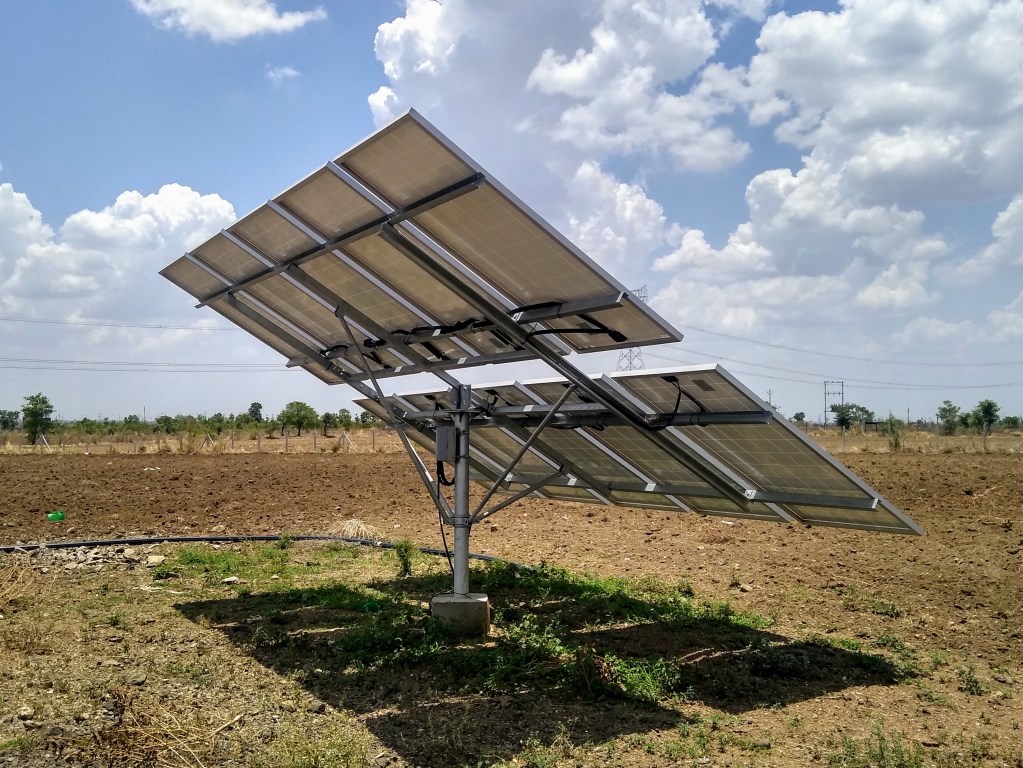Investments In Renewables Need To Triple To Meet Demand
Oct 30, 2023 | Pratirodh Bureau
Solar panels powering a water pump (Photo by Shailsh Telang/Wikimedia Commons)
- India’s energy demands will exceed that of every country in the next three decades. Its emissions are also projected to increase by 30 percent by 2050.
- The production-linked incentive scheme announced by the government, to ramp up solar PV manufacturing capacity could help India reduce import dependence and increase installed capacity, finds a new report.
- Tripling renewable energy capacity, doubling the pace of energy efficiency, ramping up electrification and reducing methane emissions from fossil fuel operations can help the world stay on track for 1.5 degrees of warming, the report says.
India is likely to see the highest growth in energy demand over the next three decades compared to every other country and region in the world, the latest World Energy Outlook report released by the International Energy Agency (IEA) says. Much of this growth will be spurred by demands for cooling as heat worsens.
The World Energy Outlook, released on October 24, assesses current energy trends and makes suggestions for future pathways for growth. The report finds that global investments in clean energy have risen by 40 percent since 2020 and that limiting global warming to 1.5 degrees above pre-industrial levels is possible but will be “very difficult.”
India’s rising energy demands also mean its emissions will increase by another 30 percent by 2050, the report says. India is currently the third largest emitter of carbon dioxide, emitting approximately 2.7 billion tonnes per year, behind the United States of America and China.
The Intergovernmental Panel on Climate Change (IPCC) has warned that emissions need to reduce by over 40 percent by 2030 in order to limit global warming to 1.5 degrees by the end of the century and reach net-zero emissions by 2050. The share of fossil fuels in the global energy supply is projected to reduce from 80 percent currently to 73 percent by 2030. “However, if demand for these fossil fuels remains at a high level, as has been the case for coal in recent years, and as is the case in the Stated Policies Scenario (STEPS) projections for oil and gas, it is far from enough to reach global climate goals,” says the IEA’s report. The STEPS scenario reflects the current situation.
China has “an outsized role in shaping global energy trends,” and if it chooses to slow its GDP growth from the projected 4 percent by 2030 to 3 percent, “this would reduce 2030 coal demand by an amount almost equal to the volume currently consumed by the whole of Europe.”
The IEA says the solution lies in tripling renewable energy capacity, doubling the pace of energy efficiency, ramping up electrification and reducing methane emissions from fossil fuel operations, which together “provide more than 80% of the emissions reductions needed by 2030 to put the energy sector on a pathway to limit warming to 1.5 °C.”
In addition, innovative, large-scale financing mechanisms are required to support clean energy investments in emerging and developing economies, as are measures to ensure an orderly decline in the use of fossil fuels, including an end to new approvals of unabated coal-fired power plants.
Cooling, Solar PVs In India
Heatwaves in India are likely to become more frequent and intense with global heating, several studies show. The heatwaves in the summer of 2022 were found to be more likely due to the effects of climate change. This, coupled with a rise in populations moving to urban areas will cause ownership of air conditioners to skyrocket by nine times by 2050, the IEA projects. “As a result, demand for oil and natural gas increases in the STEPS by nearly 70% between 2022 and 2050, while coal demand increases by 10%.”
India’s demand for air conditioning alone “exceeds total electricity consumption in the whole of Africa today,” the report highlights. However, if India were to achieve all its stated climate and energy goals, electricity demand would reduce by 15 percent compared to projections in the current scenario, due to the use of energy efficient air conditioning and thermal insulation in buildings. “This reduction itself is larger than the total electricity generation by several countries today, such as that of the Netherlands,” says the report.
India has committed to achieving net-zero emissions by 2070. At the United Nations climate conference COP27 in Sharm el-Sheikh, it released its strategic roadmap to reaching this goal, which includes increasing nuclear capacity three-fold by 2032 and ramping up green hydrogen production, among other measures. India has also set a national goal of installing 500 gigawatts of non-fossil energy capacity by 2030.
In order to meet this goal, renewable energy investments need to triple, says the IEA. In 2022, investments to renewable energy numbered $60 billion, and are likely to double by 2030 going by current projections.
The report notes that India has made headway with its solar PV (photovoltaic) production-linked incentive (PLI) scheme which can potentially reduce import dependence. Between 2021 and 2022, India imported $3.4 billion worth of solar PVs. The PLI scheme aims to add 65 GW of new manufacturing capacity every year, and this year, a total of 48 GW of new capacity was considered eligible for subsidy awards once manufacturing begins.
According to the IEA report, “If the new solar PV module manufacturing capacity under the PLI programme comes fully online by 2026, it would progress the solar PV module manufacturing capacity in India to well over what is needed until the end of this decade.”
(Published under Creative Commons from Mongabay-India. Read the original article here)
